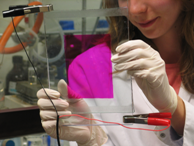Solar Cells
 The sun provides the earth with energy at a rate of more than 100 000 TW (1 terawatt = 1 trillion watts = 1012 W). This corresponds
to more energy in an hour than the global fossil energy consumption in a year. This vast energy resource was first harnessed by living organisms over
2 billion years ago when molecular mechanisms of photosynthesis were developed. Photosynthetic organisms use the sun's energy to split water into
oxygen (which we breathe) and hydrogen, which the organisms combine with atmospheric carbon dioxide to form the organic molecules that
constitute the global biomass.
The sun provides the earth with energy at a rate of more than 100 000 TW (1 terawatt = 1 trillion watts = 1012 W). This corresponds
to more energy in an hour than the global fossil energy consumption in a year. This vast energy resource was first harnessed by living organisms over
2 billion years ago when molecular mechanisms of photosynthesis were developed. Photosynthetic organisms use the sun's energy to split water into
oxygen (which we breathe) and hydrogen, which the organisms combine with atmospheric carbon dioxide to form the organic molecules that
constitute the global biomass.
Solar cells offer an artificial means of utilising solar energy. The current generation of crystalline and amorphous silicon solar cells have efficiencies between 5% and 17%, but their fabrication is expensive and consumes a lot of energy. A promising and potentially cheaper alternative is the dye-sensitized solar cell. This type of cell mimics photosynthesis by harvesting light with intensely-coloured dyes spread as a single layer of molecules on the surface of titanium dioxide nanoparticles. When the dye absorbs visible light, it mimics the action of chlorophyll in a green leaf, except that it produces electrical power rather than biomass. The cells, which have already exceeded 10% efficiency, can be manufactured on sheets of conducting glass or on flexible plastic films suitable for mounting on windows for power generation.
In the future, we can expect to develop these technologies further into direct analogues of photosynthesis. Such devices will be able to split water directly into oxygen and hydrogen or convert carbon dioxide to methanol and oxygen.
|
Watch an animation of a dye-sensitised cell in action!
Press the image to begin (2.4 Mb)
|

|
The Solar Cell Team
Prof. Laurie Peter, Dr Wendy Howie, Dr Steve Roser, Halina Dunn, Alberto Fattori, James Jennings.
More Information
- Download the solar cell fact sheet (1.1 Mb).
- Visit the Peter Research Group web site.


